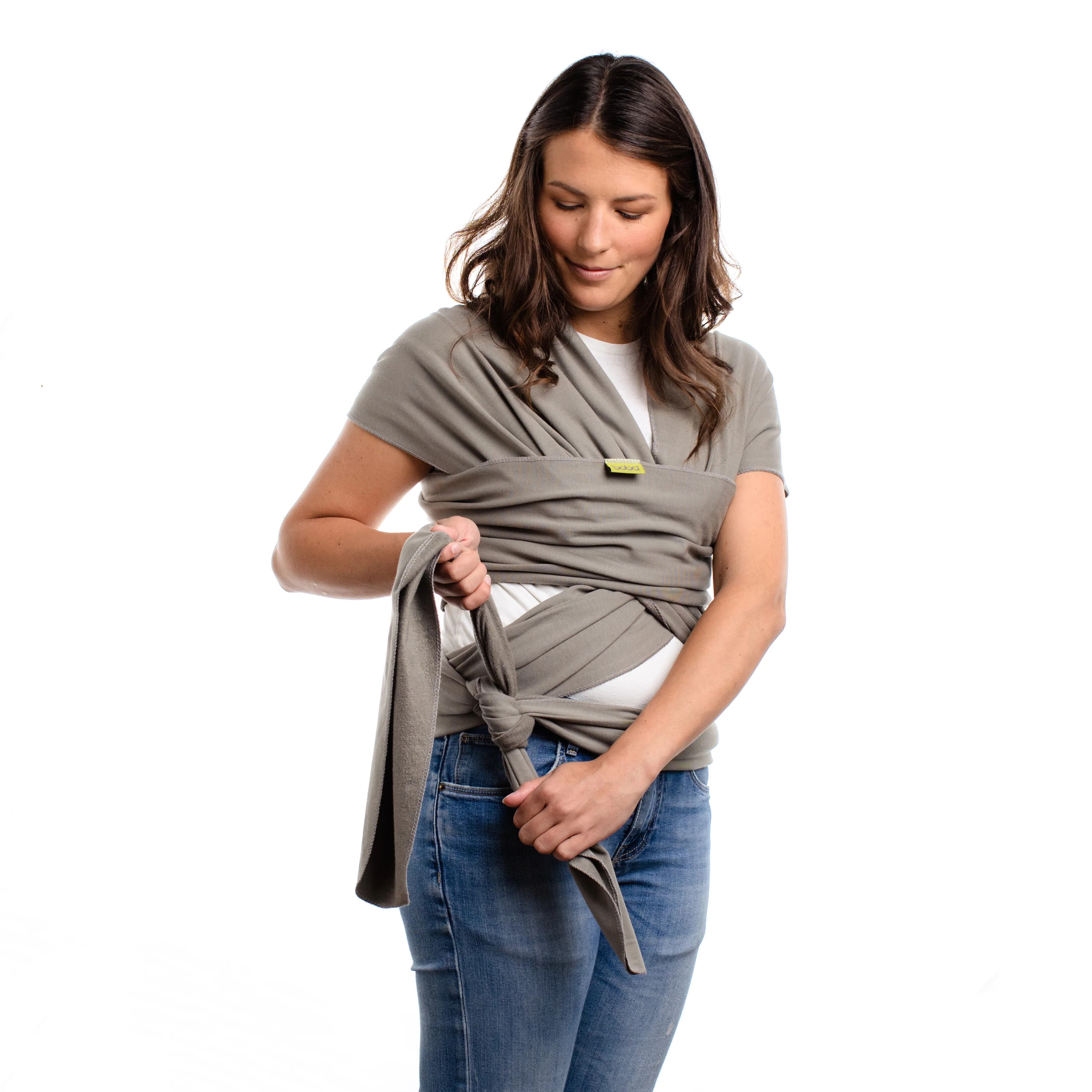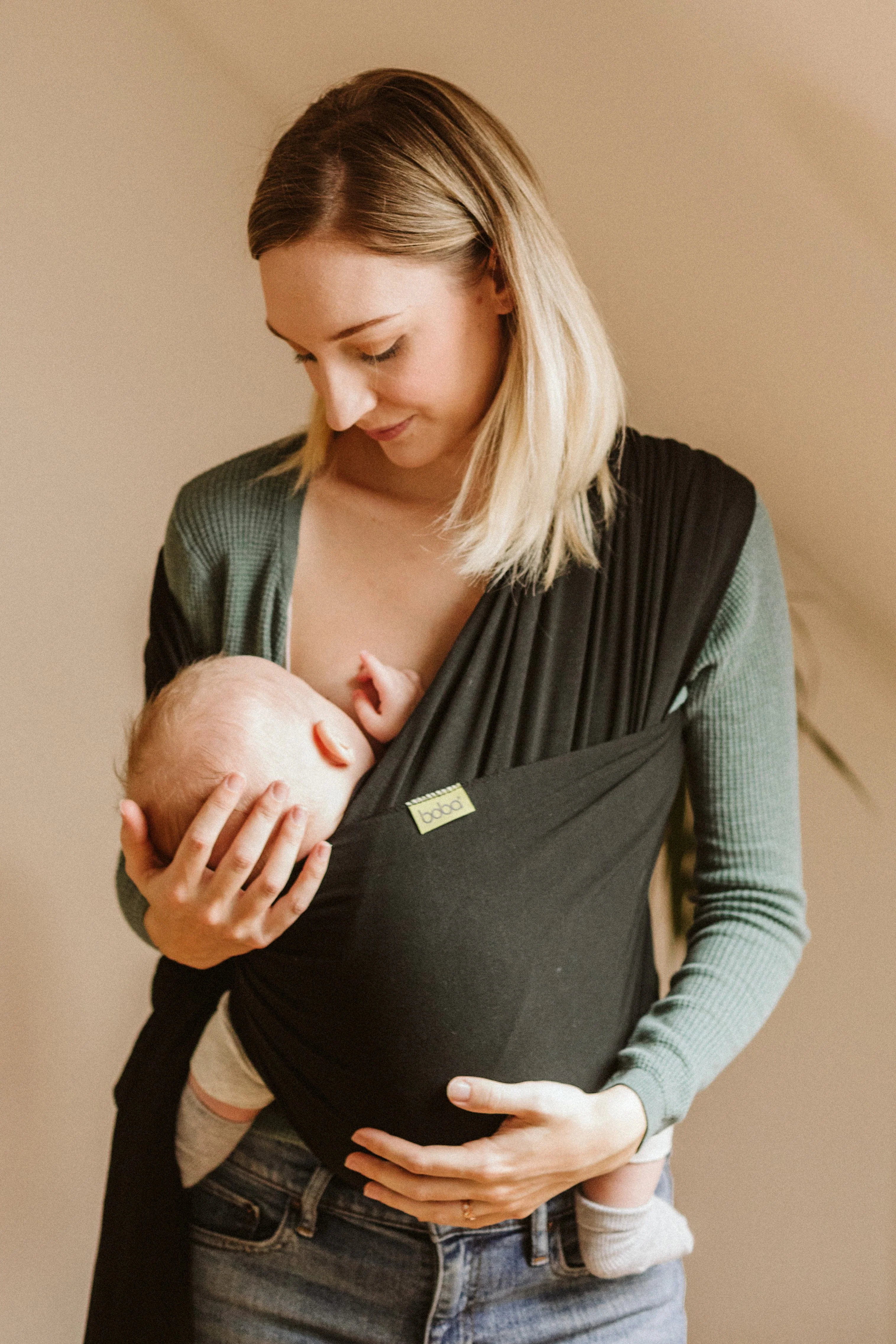Always read the instruction manual carefully before using your baby carrier to ensure safe and proper use. Remember to check on your child regularly while carrying, making sure they are comfortable and secure at all times.

Boba Wrap
This will be amazingly snug and comfortable but remember — it’s a new experience for both you and your baby!
Make sure that baby is well-fed and not overtired when you first start using the carrier.
Try practicing in front of the mirror.
If baby starts getting fussy, just take a deep breath and a few steps around the room until you’re both ready to continue.
Once positioned correctly, your baby should be snug against your body, high on your chest, enabling you to stand normally, just as if you were holding them in your arms.
For personalized one-on-one support from the comfort of your home, book a free fit consultation!
Tying your Boba Wrap
NAILING THE TIE EVERY TIME
The key to success is getting the tension right before you put the baby in!
Tying the wrap nice and snug will ensure your baby doesn’t slip, sag or slump in the carrier and that wearing your baby feels like wearing a hug - comfortable, secure, and safe!
When tying your Boba Wrap, aim to tie it so it feels as tight and clings to your body as an athletic top.
There is no need to tie the wrap loosely or leave space for the baby as the elasticity of the wrap will provide a snug fit!


"Love Your Baby" hold
PERFECTLY SNUG FIT
Here are a few key points for a comfortable and secure carry:
A. When the wrap is tied for a perfect fit, take your baby in your arms and position them on your chest in a secure ergonomic position.
B. Ensure the wrap is spread equally from knee pit to knee pit.
C. Each pass of the wrap should come up to the back of baby's neck.
The even weight distribution will prevent your baby from slumping sideways or their legs dropping down.
D. Baby's torso should be snug against yours to keep the chest cavity uncurled and the chin of the chest.
E. Your baby should feel secure even if you were to lean forward (with one hand on the baby's head).

The T.I.C.K.S Rule for Safe Babywearing
T - Tight: Keep the carrier snug against you for secure baby positioning.
I - In View: Always see your baby's face to ensure clear airways.
C - Close for Kiss: Position baby high enough for easy kissing.
K - Keep Chin Up: Ensure baby's chin isn't resting on their chest.
S - Supported Back: Maintain baby's back in a natural, supported position.
Remember these tips for safe and comfortable babywearing!
Source: UK Sling Consortium

Facing in is best for you and your baby.
The inward-facing carry, also known as the “tummy to tummy” position, keeps the baby as close to your center of gravity as possible, so their weight is distributed evenly around your body as baby curls in. Wearers often need to lean back to compensate for the baby’s weight when facing out.
The spread squat oriented towards the parent position allows for good airflow, spine and hip support. It is also a safe position for babies to sleep - not to mention a common favorite place to nap with their little head resting on your chest surrounded by the familiar smell and sound of your heartbeat!


Optimal support for those developing hips!
Small infants have gently curved spines, and their natural ergonomic position is with their knees drawn up into a comfortable “M shape”/frog position/spread squat.
From this wide seat base, babies can be properly supported all the way up to the back of the neck, and their weight is equally distributed, thus preventing the babies from slumping in the carrier (or if they are being carried in arms).
To ensure your baby is in an optimal ergonomic position, you can hold your baby’s legs under their knee pits and gently scoop them towards your body in an upwards motion, rotating and tucking their pelvis under. This helps create a “J shape” (from the side) or an “M shape” (from the front) position!
This ergonomic positioning also helps encourage healthy hip development and prevent hip dysplasia!

Breastfeeding in the Boba Wrap
Enjoy effortless breastfeeding on the go!
STEP 1: Loosen the wrap by grabbing the fabric at your shoulders and pulling the forward to get some slack
STEP 2: Scoot baby down and reach under the shoulder pass
STEP 3: Hold your breast and latch!
Once your baby is done nursing, scoot them back up and redistribute the slack along the wrap to get a snug fit.
It may take some practice, but you'll get the hang of it in no time!


Head support for a little (sleeping) baby.
The side rail of the wrap works as perfect head support for a newborn (if they will tolerate it) or a sleeping baby.
Gather, fold or flip the other shoulder pass for airflow and visibility and always make sure your baby’s face is unobstructed by any kind of fabric and that their nose and mouth are at least parallel with the floor or pointing up.
A practical accessory throughout the day!
You can pre-tie your wrap before putting your baby in!
This means you can put it on with the rest of your outfit in the morning, and it can stay on all day so you can tuck your baby in easily when needed and simply take them out just as quickly.
No re-tying required!

How to wear a big baby in the Boba Wrap
The Boba Wrap can be extremely useful for cuddling bigger babies or even toddlers on days when they might need extra love and comfort. The gentle all-around pressure helps reduce excessive stimuli and allows a baby to rest more peacefully, not to mention the magic of your touch and closeness.
Take a look at some of our tricks for wearing a big (little) one with a wrap with no sagging!

If the fit still has room for improvement...
BABY IS TOO HIGH UP OR THE WRAP FEELS TOO TIGHT
If the wrap feels too tight or baby is too high up on your chest, try the following before retying:
Walk around a bit as our Boba Wrap is stretchy and has a lot of give. Your baby will naturally settle down a little lower.
You can also lower your baby a bit by putting your hands inside the carrier, stretching the wrap out a bit, and scooting them down a little.
BABY FEELS TOO LOW OR TOO LOOSE
Make sure your Boba Wrap is snug. When tying, take time to make sure all the passes of the wrap are tight, and there is no excess slack before putting the baby in.
If you feel the baby sagging in the carrier, you can get rid of the slack by tightening the fabric, starting at the logo on the horizontal pass and following along the wrap. Once you've reached the knot, just untie and retie without the excess fabric.
In general, it's better to tighten more, and you can still let the wrap out a bit without having to retie completely.

All wrapped up in love.








